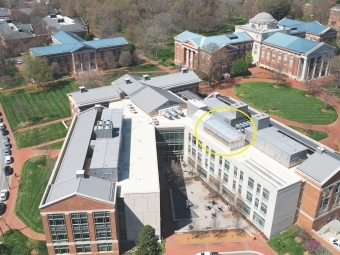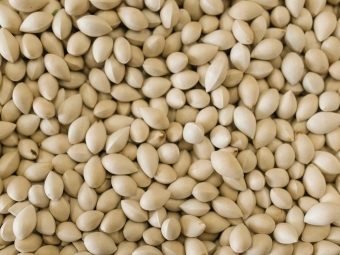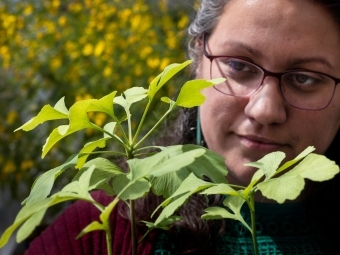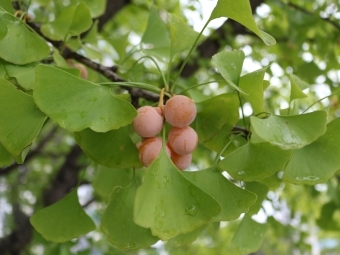Seeds of Change: Saplings Grown From Seeds of Trees That Survived Hiroshima Bombing Model Resilience
April 25, 2024
- Author
- Jay Pfeifer
A partnership between Davidson College and Green Legacy Hiroshima brings Gingko trees to campus that are descendents of trees that survived the bombing of Hiroshima. The saplings represent resilience and will be planted in the center of campus.
In late April, eight Ginkgo biloba saplings will be planted in the grassy oval between the E. Craig Wall Jr. Academic Center and the Sculpture Garden.
There, they will form the leading edge of a new canopy of trees that will bring shade and an eye-popping fall display when their fan-shaped leaves turn a bright yellow and fall to the ground in a single day. But these ginkgos bring something more to campus – they bring a story.
These tiny saplings are descendants of trees that survived the atomic bombing of Hiroshima.
Their journey to Davidson College started in 2016 when Kristi Multhaup, Vail Professor of Psychology, participated in an ASIANetwork seminar in which professors from roughly 10 colleges traveled to Japan and studied collective memory.
The seminar members spent most of their time in Tokyo and Kyoto but a side trip to Hiroshima opened Multhaup’s eyes.
Her group met with representatives of Green Legacy Hiroshima, an organization that nurtures more than 160 hibakujumoku, or “atomic bombed trees.” The organization distributes seeds from those survivor trees around the world to share a message of peace and resilience.
Multhaup returned to Davidson and immediately began building a network of supporters and helpers that stretched from the Biology Department to Physical Plant to the office of the Vice President for Academic Affairs.
I raised my hand to say, this sounds fantastic. Is there a process by which people can apply for these seeds? I would love to involve our campus in this effort. And they said, absolutely.
Vail Professor of Psychology
Part of a Larger Story
The project took into consideration the broader history of the World War II era, which was reflected in the tree-planting ceremony on April 26.
“Today, nearly eighty years after the end of the war, the U.S. military’s decision to use nuclear weapons against the Japanese population and the memory and legacy of Japanese military aggression in East and Southeast Asia remain highly politically charged issues,” Assistant Professor of History Dasa Mortensen said during remarks to the crowd.
Mortensen chronicled Japanese war crimes and aggression against China, Korea and the Philippines, including: the killing of 30 million mostly civilian Chinese, chemical and biological warfare experiments on Chinese captives in Manchuria and the forced sexual slavery of hundreds of thousands of women from China, Korea, Taiwan and the Philippines.
“Japanese leaders have found it challenging to publicly reflect on their country’s role in the war,” Mortensen said, “given that Japan was both a military aggressor and suffered from two nuclear attacks.”
Multhaup told the story of the peace activist survivors in Japan who refused to cooperate with atomic bombing commemorations that didn’t include the full story of Japanese militarism and imperialism.

Today, the Pat Peroni Greenhouse sits atop the roof of the Wall Center.
From Seeds to Ceremony
In 2018, a batch of seeds were delivered to Biology Professor Pat Peroni. Unfortunately, at about the same time, Peroni was diagnosed with cancer. She passed away in 2019 and during her fight against the disease, the seeds sat on Peroni’s desk. By the time the seeds were recovered, they had germinated in their container and it was too late to save them.
Multhaup didn’t abandon the project, however. In 2022, a batch of 20 new ginkgo seeds were delivered to Biology Professor Susana Wadgymar. She took them up to their home: a new greenhouse on the roof of the Wall Center named in honor of Peroni.
The new facility was a perfect home for the seeds, light brown spheres about the diameter of a quarter.
The greenhouse, as one might expect, was an ideal place to raise Ginkgo biloba. The controlled light and temperature allowed for long growing seasons and easy winters.
But as a species, the ginkgo is a survivor. It is the only living tree species that coexisted with dinosaurs. Fossils indicate that the ginkgo has bloomed on this planet for more than 270 million years. They vanished from North America and Europe at some point and were thought to be extinct until they were discovered in Japan in the 17th century.
A small planting ceremony on April 26 will mark a milestone in these survivors’ march to maturity. The celebration will share the trees’ story and participants will help plant the saplings. They can also fold and hang paper cranes around the young trees.
In about 20 years, the trees will have one more big surprise for the Davidson community.

Ginkgo biloba seeds

Biology Professor Susana Wadgymar holds a tray of ginkgo saplings
“We won’t know whether these plants are male or female until then,” Wadgymar said. "It’s actually a crucial distinction. Female ginkgos grow a fruit that produces a nose-wrinkling smell.”
Davidson arborist Jamie Moore said, “When people are around ginkgo fruit, everyone starts checking their shoes because they think they have stepped in something.”

The female ginkgo tree grows a round, brown fruit that produces an unpleasant smell.
The odor is strong enough that female ginkgos are frequently culled. (That decision will be left to future generations.)
Multhaup would like this little cluster of ginkgos to become more than just a stunning yellow backdrop in the fall. She hopes that they will become a refuge; a place for community gatherings.
“The history of these trees makes them symbols of resilience, and Green Legacy Hiroshima shares them as symbols of peace. When current events inspire the college community to gather, I hope the gathering location will be around these trees,” she said. “Fortunately, the bricks around the green space make it accessible for everyone.”
Most of all, Multhaup hopes that when students, faculty and staff gather around these ginkgos that have withstood a horrifying act of war, they see resilience.
“These are descendants of trees that survived an atomic bomb,” she said. “Whatever inspiration we need to survive, we can find that here.”
College Arboretum
Davidson College's 600-acre campus is an accredited Level I arboretum. A tree inventory is available in an interactive database.



